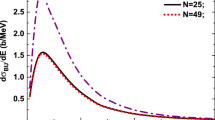Abstract.
We discuss the quasi-adiabatic approximations to the three-body wave-function in breakup processes and clarify the assumptions underlying the model. This suggests alternative approximation schemes. Using different theoretical three-body models, calculated angular distributions of differential cross sections for the 11Be(p,d) reaction are presented, for which new preliminary data have been reported at 35 MeV. We show that calculations are sensitive to the inclusion of deuteron breakup and to the breakup model used, particularly if absolute spectroscopic information on the 0+ and 2+ 10Be core-state parentages is deduced. There is also considerable sensitivity to the model employed in calculations of the relative cross sections of the two states.
Similar content being viewed by others
Author information
Authors and Affiliations
Additional information
Received January 19, 1999; revised April 16, 1999; accepted for publication February 28, 2000
Rights and permissions
About this article
Cite this article
Yilmaz, M., Gönül, B. Significance of Deuteron Breakup in Halo Transfer. Few-Body Systems 29, 223–235 (2000). https://doi.org/10.1007/s006010070002
Issue Date:
DOI: https://doi.org/10.1007/s006010070002




